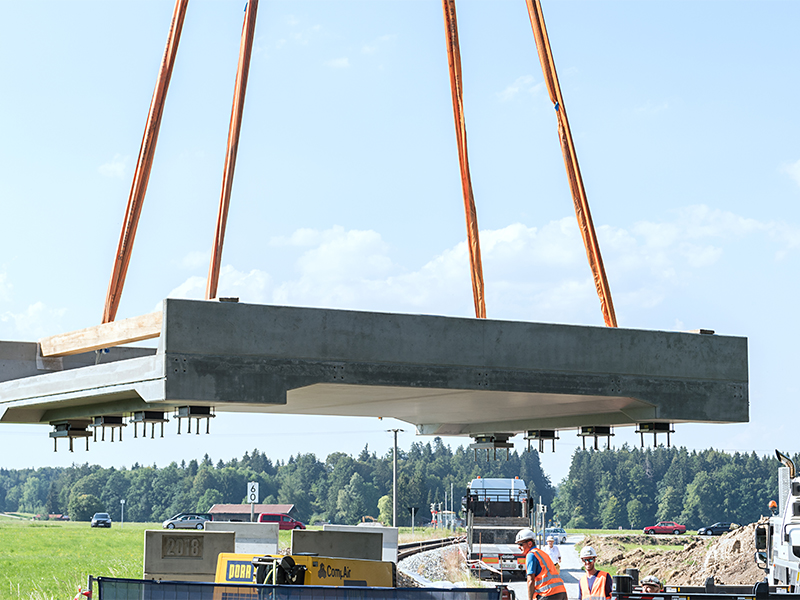Tegernsee: Germany's first railroad bridge made of ultra-high performance concrete
A thinner bridge with enormous strength

It is almost as resilient as steel, has a long service life and makes especially thin structures possible: Ultra-high performance concrete, which is still only rarely used in Germany in spite of its positive properties. "This is a new material which behaves differently from conventional concrete," explains Prof. Oliver Fischer of the TUM Chair of Concrete and Masonry Structures. "Germany has yet to introduce a set of regulations for its use."
The material has been the subject of international research for years – including at the Technical University of Munich (TUM). The special thing about it: Its composition makes the material exceptionally dense, with almost no internal cavities that can be penetrated by moisture or salts which could damage the material. Ultra-high performance concrete is also much stronger, able to withstand four to five times the pressure which the conventional concrete currently used in bridge construction can take.
25 centimeters thinner
The material is ideal for the 6.50 meter long railroad bridge over the Dürnbach river near Gmund in Bavaria: To provide for flooding, the distance between the river's surface and the lower edge of the new bridge was to be as large as possible. The innovative material and more slender railroad sleepers made it possible to reduce the structural height by more than 25 centimeters.
The new bridge component made of ultra-high performance concrete is relatively light, so that the foundation elements from the previous bridge could be re-used. The comparatively low weight of the bridge made transport and installation of the structure considerably easier; as a result it was only necessary to close down the tracks for a short period of time.
Measurements during ongoing operations
The bridge was commissioned and supported by the Tegernsee-Bahn GmbH (TBG) rail company. TBG CEO Heino Seeger explains why: "Tegernsee-Bahn actively promotes future-oriented forms of passenger rail traffic. This includes helping develop rail infrastructures in the best way possible. An intensive feasibility study on the use of the new material indicated essential design advantages for the pilot project. We are pleased to have been able to support TU Munich in this initial application for a railway bridge and to make yet another important contribution on behalf of the local Oberland region."
By making measurements during ongoing operations, the researchers hope to make important findings which will be incorporated among other things in the development of a future set of regulations for the application of the material, which - for example – also may be applied as a strengthening layer on existing concrete and/or steel bridges. The first measuring results confirm the design assumptions and structural analyses.
short carbon fibers from the 3D printer
The ultra-high performance concrete owes its high density and strength to an exactly defined ratio of cement particles to fine additives and scaled granularity. Steel micro-fibers are another important component of the ultra-high performance concrete, providing higher tensile strength and ductility. When the bridge is bearing a load, tensile forces have to be safely transmitted much the same way as in a rope during a tug-of-war.
In their next step the engineers want to increase the tensile strength of the ultra-high performance concrete even further: For example, with short carbon fibers from the 3D printer. Not only can these fibers be easily arranged all in a single direction in the concrete, they also interface better with the material, providing higher load bearing capacity and a longer service life.
More information:
The design of the solution, the official assessment for obtaining necessary consent on an individual case basis, draft planning and structural inspection were all performed by the TUM Chair of Concrete Structures in collaboration with the engineering firm Büchting+Streit AG; the execution was planned by the engineering firm SSF Ingenieure AG. The finished bridge component was manufactured by the Max Bögl Group construction company, using a UHPC compound from vendor HeidelbergCement AG.
The Bavarian construction industry association Stiftung Bayerisches Baugewerbe provided financial support for supervision and measurements monitoring the pilot bridge.
Contact:
Prof. Dr. Oliver Fischer
Technical University of Munich
Chair of Concrete and Masonry Structures
oliver.fischer@tum.de
+49 (89) 289 - 23038